

Original Parish Churches
Five roads from Piazza del Comune led to the five gates in the 12th century walls, each of which became associated with a parish church. The earliest of these was Santa Maria del Popolo, which was first documented in 1213 inside the Portone di Santa Maria. During the course of the following decades, four other churches were transferred from rural sites to sites within the town walls:
-
✴San Bartolomeo, inside Porta San Bartolomeo, which has its own page in this website;
-
✴San Giovanni di Colle Mora, outside Porta San Clemente, which gave its name to Borgo di Colle Mora;
-
✴San Lorenzo, outside Porta San Lorenzo; and
-
✴Santa Maria di Turri, outside Porta Camiano.
Santa Maria del Popolo subsequently passed to the Augustinians. In 1599, the parochial responsibilities of the other four were concentrated on San Bartolomeo.
Santa Maria del Popolo (demolished)
This church inside Portone di Santa Maria, which was first documented as such in 1213, was the original parish churches of Montefalco. The Blessed Angelo da Foligno founded the Augustinian convent here in 1257, only a year after the “grande unione” had given rise to the order. This promoted the settlement of a new suburb that became known as Borgo del Castellare.
The Augustinians retained Santa Maria del Popolo after they built their new church and convent of Sant’ Agostino outside Portone di Santa Maria. It passed to the Compagnia delle Misericordia in 1571. It was found to be in a very bad state of repair during a visit by Bishop Pietro Carlo Benedetti of Spoleto in 1727, but it was not finally demolished until the early 19th century.
San Giovanni di Colle Mora (demolished)
The first church of this denomination was documented in the 11th century at Colle Mora, some 2 km west of Montefalco. It probably moved to a site outside the town walls in the early 13th century, and gave its name to the surrounding suburb. It was first documented here in 1269. In 1333, the adjacent house, which belonged to the rector, was used for the Tribunal of the Duchy of Spoleto.
The parish was suppressed in 1599, and its parochial responsibilities were transferred to San Bartolomeo. The church was incorporated into the hospital that had been set up in the adjacent ex-convent of San Francesco in 1860.
[The original portal was incorporated into Villa Mattioli, in Via del Verziere].
Frescoes (ca. 1400)
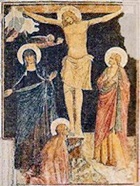
-
✴the much re-painted Crucifixion with the Virgin and St John the Evangelist, and with St Mary Magdalene kneeling at the foot of the cross (illustrated here);
-
✴St Margaret in prison; and
-
✴a very damaged and heavily repainted fresco of the Madonna and Child enthroned, which is attributed to the Maestro della Dormitio di Terni.
San Lorenzo (12th century), later Santa Maria delle Grazie
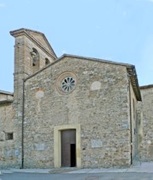
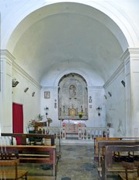
This church, which was originally dedicated to San Lorenzo, is one of the oldest parish churches in Montefalco, although it was first documented only in 1295. [The original Romanesque façade was recently discovered in the adjacent house.]
The church was radically restored in 1486-9. The parish was suppressed in 1599 and its parochial responsibilities were transferred to San Bartolomeo.
The church received its current dedication in 1769, when an image (see below) that was rediscovered in the church performed a miracle. The church was again restored in 1907.
Madonna delle Grazie (16th century)
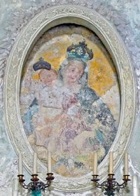
Santa Maria di Turri (demolished)
A church of this dedication was first documented near Porta Camiano in 1226. Bishop Berardo Eroli of Spoleto commissioned its restoration in 1471. The parish was suppressed in 1599 and its parochial responsibilities were transferred to San Bartolomeo. It subsequently fell into ruins and was demolished in 1883.
Frescoes (ca. 1471)
The frescoes that had been painted on the semi-circular apse after its restoration were detached before the church was demolished. They had to be cut into four parts and stuck to a flat surface before their transfer to the Pinacoteca. The frescoes depict:
-
✴the Madonna and Child enthroned, with angels;
-
✴SS Peter and Stephen to the sides; and
-
✴the Crucifixion with the Virgin and St John the Evangelist, and with St Mary Magdalene kneeling at the foot of the cross.
Other Churches
Santa Elisabetta di Vecciano (1628)
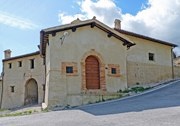
The church was built to house an aedicule that contains a venerated image of the Madonna and Child (see below).
Madonna and Child with musical angels (early 16th century)
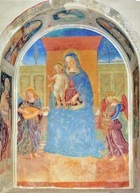
-
✴John the Baptist and Sebastian, to the sides; and
-
✴SS Peter and Francis and the Lamb of God above.
Santa Lucia (12th century)
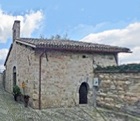
The truncated side door seems to lead to a crypt.
I have not managed to see inside, but there is an interesting description in Bill Thayer’s website.
Santa Maria dei Laici (17th century)
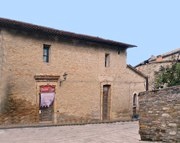
This complex belonged to the Confraternita di Santa Maria dei Laici, which was documented in 1275, when it was based at the Franciscan convent of Santa Maria della Selvetta (later San Rocco). The confraternity, which was closely associated with the Franciscans, probably moved to the present site when the Franciscans moved nearer to Montefalco ca. 1275. They had their main oratory here, together with an adjacent hospice and a subterranean oratory used by female members.
The confraternity rebuilt their church and hospice in the late 17th century.
A congregation of Oratorian Fathers moved here in 1697 and stayed until 17o5, when they moved to their new church of San Filippo Neri. The complex was later abandoned and subsequently adapted for secular use.





